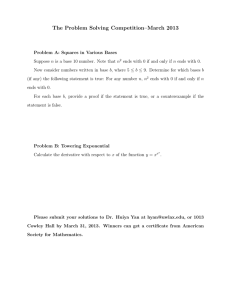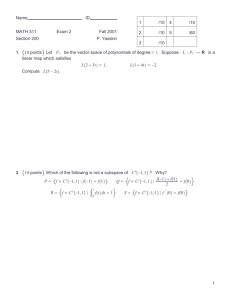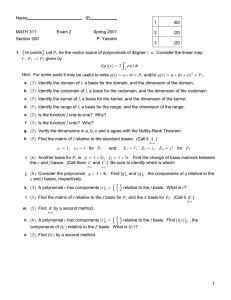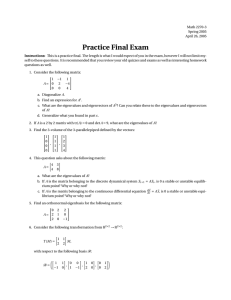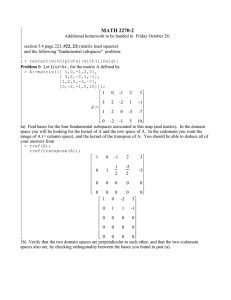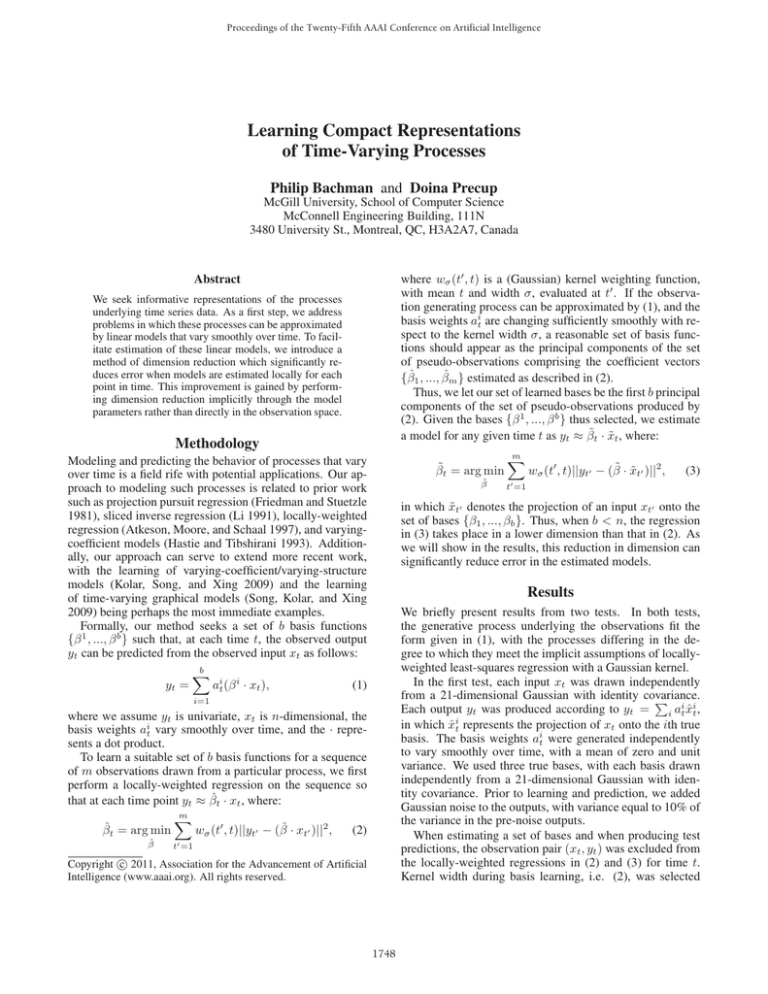
Proceedings of the Twenty-Fifth AAAI Conference on Artificial Intelligence
Learning Compact Representations
of Time-Varying Processes
Philip Bachman and Doina Precup
McGill University, School of Computer Science
McConnell Engineering Building, 111N
3480 University St., Montreal, QC, H3A2A7, Canada
where wσ (t , t) is a (Gaussian) kernel weighting function,
with mean t and width σ, evaluated at t . If the observation generating process can be approximated by (1), and the
basis weights ait are changing sufficiently smoothly with respect to the kernel width σ, a reasonable set of basis functions should appear as the principal components of the set
of pseudo-observations comprising the coefficient vectors
{β̂1 , ..., β̂m } estimated as described in (2).
Thus, we let our set of learned bases be the first b principal
components of the set of pseudo-observations produced by
(2). Given the bases {β 1 , ..., β b } thus selected, we estimate
a model for any given time t as yt ≈ β̃t · x̃t , where:
Abstract
We seek informative representations of the processes
underlying time series data. As a first step, we address
problems in which these processes can be approximated
by linear models that vary smoothly over time. To facilitate estimation of these linear models, we introduce a
method of dimension reduction which significantly reduces error when models are estimated locally for each
point in time. This improvement is gained by performing dimension reduction implicitly through the model
parameters rather than directly in the observation space.
Methodology
Modeling and predicting the behavior of processes that vary
over time is a field rife with potential applications. Our approach to modeling such processes is related to prior work
such as projection pursuit regression (Friedman and Stuetzle
1981), sliced inverse regression (Li 1991), locally-weighted
regression (Atkeson, Moore, and Schaal 1997), and varyingcoefficient models (Hastie and Tibshirani 1993). Additionally, our approach can serve to extend more recent work,
with the learning of varying-coefficient/varying-structure
models (Kolar, Song, and Xing 2009) and the learning
of time-varying graphical models (Song, Kolar, and Xing
2009) being perhaps the most immediate examples.
Formally, our method seeks a set of b basis functions
{β 1 , ..., β b } such that, at each time t, the observed output
yt can be predicted from the observed input xt as follows:
yt =
b
ait (β i · xt ),
β̃t = arg min
β̃
wσ (t , t)||yt − (β̃ · x̃t )||2 ,
(3)
t =1
in which x̃t denotes the projection of an input xt onto the
set of bases {β1 , ..., βb }. Thus, when b < n, the regression
in (3) takes place in a lower dimension than that in (2). As
we will show in the results, this reduction in dimension can
significantly reduce error in the estimated models.
Results
We briefly present results from two tests. In both tests,
the generative process underlying the observations fit the
form given in (1), with the processes differing in the degree to which they meet the implicit assumptions of locallyweighted least-squares regression with a Gaussian kernel.
In the first test, each input xt was drawn independently
from a 21-dimensional Gaussian with identity covariance.
i i
Each output yt was produced according to yt =
i at x̂t ,
in which x̂it represents the projection of xt onto the ith true
basis. The basis weights ait were generated independently
to vary smoothly over time, with a mean of zero and unit
variance. We used three true bases, with each basis drawn
independently from a 21-dimensional Gaussian with identity covariance. Prior to learning and prediction, we added
Gaussian noise to the outputs, with variance equal to 10% of
the variance in the pre-noise outputs.
When estimating a set of bases and when producing test
predictions, the observation pair (xt , yt ) was excluded from
the locally-weighted regressions in (2) and (3) for time t.
Kernel width during basis learning, i.e. (2), was selected
(1)
i=1
where we assume yt is univariate, xt is n-dimensional, the
basis weights ait vary smoothly over time, and the · represents a dot product.
To learn a suitable set of b basis functions for a sequence
of m observations drawn from a particular process, we first
perform a locally-weighted regression on the sequence so
that at each time point yt ≈ β̂t · xt , where:
m
wσ (t , t)||yt − (β̂ · xt )||2 ,
(2)
β̂t = arg min
β̂
m
t =1
c 2011, Association for the Advancement of Artificial
Copyright Intelligence (www.aaai.org). All rights reserved.
1748
Regression error by PPC basis count and kernel width
through cross-validation to maximize performance of the
learned bases during prediction, i.e. (3).
Figure 1 shows results from our first test. These illustrate
the way in which prediction error varied as a function of
the number of learned bases and the kernel width used during the regression in (3). Prediction error was measured as
the variance of the difference between the predicted output
and the pre-noise output, divided by the variance of the prenoise output. Prediction errors less than 0.1, as produced
by our method when using the “correct” number of bases,
correspond to predictions more accurate than the noisy observations available in the learning and prediction phases.
Figure 1 shows that the optimal kernel width increases with
the number of bases used, as one would expect from the effective increase in dimension. Our method performed best
when using three learned bases, because these bases closely
approximate the subspace spanned by the true bases and the
effective dimension reduction permits a smaller kernel width
during prediction, which allows closer tracking of changes
in the true model.
0.9
Regression error
0.8
0.7
0.6
0.5
0.4
0.3
0.2
Full, 12
Small, 4
Small, 6
Small, 8
Small, 10
True, 4
Figure 2: A boxplot of prediction error as a function of approximate basis function count and kernel width when modeling a time-varying process with ten sparse basis functions.
The boxes are labeled (x,y), where x is the learned basis set
size and y is the prediction kernel width. The “full” set used
50 bases, the small set used 10 bases, and the “true” set used
the true bases.
Regression error by PPC basis count and kernel width
0.5
3 bases
Regression error
0.45
kernel width. As in the first test, selecting a smaller set of basis functions, thus reducing the dimension of the regression
in (3) by restricting ourselves to only the most “important”
dimensions of the parameter space, permits more accurate
model estimation and more precise tracking of variation in
the underlying model with a smaller kernel width. The kernel width used with a full set 50 of bases was selected to
optimize prediction performance, while the range of widths
used with a reduced set of 10 bases was selected to include
the optimum.
Our tests show that the specific method we have introduced should prove useful, while the underlying approach
to dimension reduction in model parameter space is readily
extensible in a way that immediately suggests worthwhile
directions for future work.
5 bases
0.4
13 bases
0.35
21 bases
true bases
0.3
0.25
0.2
0.15
0.1
0.05
0
5
10
15
20
Kernel width
25
30
35
Figure 1: A plot of prediction error as a function of learned
basis function count and kernel width when modeling a process defined by a smoothly-varying linear combination of
three fixed basis functions. Using the minimal set of learned
bases capable of spanning the true process space produces
much better estimates of process behavior/state.
References
Atkeson, C. G.; Moore, A. W.; and Schaal, S. 1997. LocallyWeighted Learning. Artificial Intelligence Review 11(15):11–73.
Friedman, J., and Stuetzle, W. 1981. Projection Pursuit
Regression. Journal of the American Statistical Association
76(376):817–823.
Hastie, T., and Tibshirani, R. 1993. Varying-Coefficient
Models.
Journal of the Royal Statistical Society B
55(4):757–796.
Kolar, M.; Song, L.; and Xing, E. P. 2009. Sparsistent Learning of Varying-Coefficient Models with Structural Changes.
In Neural Information Processing Systems 23.
Li, K.-C. 1991. Sliced Inverse Regression for Dimension
Reduction. Journal of the American Statistical Association
86(414):316–327.
Song, L.; Kolar, M.; and Xing, E. P. 2009. Time-Varying
Dynamic Bayesian Networks. In Neural Information Processing Systems 23.
Our second test involves a process that less closely
matches the assumptions of our method. For this test, the
observed inputs were 50-dimensional and 10 true bases were
used. Each true basis was first drawn from a 50-dimensional
Gaussian with identity covariance, after which its entries
were set to zero with probability 0.9, thus producing sparse
bases. The basis weights ait were set to vary more abruptly
than in the first test, with only a strict subset of the bases
having non-zero weights at each point in time, thus leading
to sparse effective models.
For this test, during both basis learning and prediction,
we used 1 -regularized regression to better match the sparsity of the underlying process and to mitigate the effects of
high-dimensional inputs combined with an abruptly varying
process structure that mandated smaller kernel widths. Figure 2 shows results from this test, comparing the prediction
error produced by various combinations of basis set size and
1749

